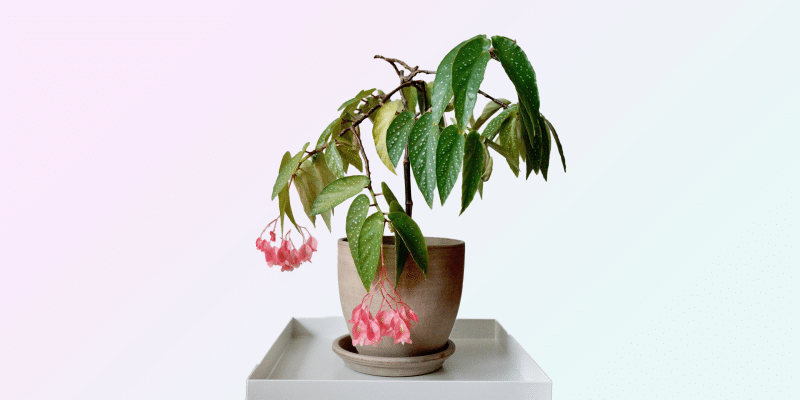If you love indoor plants, you’ve likely seen the Begonia maculata, also known as the Polka Dot Begonia.
With delicate deep green leaves, bespeckled with silver and gray, it’s no wonder that it may have grabbed your attention. It did mine!
In this article, we’ll provide you with a complete care guide for this houseplant that will help you keep it thriving.
We’ll also dive into some interesting facts about the plant, including the evolutionary advantage of its red undersides and the varieties that are available.
By the end of this article, you’ll know everything you need to know to care for your Begonia maculata and help it grow into the stunning plant it was meant to be.
Table of Contents
Begonia Maculata Care Guide
History, habitat, and characteristics
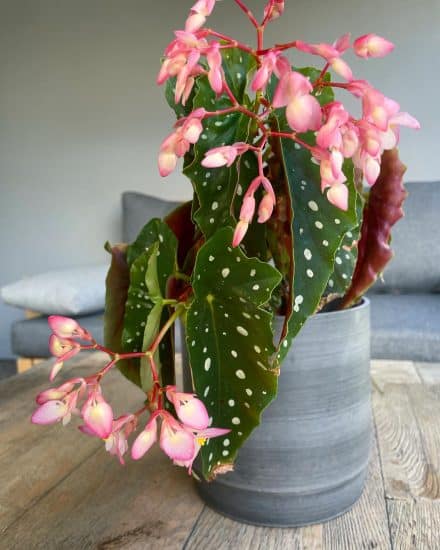
Begonia maculata, known as Polka Dot Begonia, like so many other amazing plants, comes from the tropical forests of Brazil. Originally recorded in the 1820s, this plant features deep green leaves speckled with silver and gray polka dots.
Its name comes from the Latin word “macula”, which translates to spotted. Underneath the leaves, you’ll notice red undersides, which make them beautiful to keep as houseplants but also thought to give them a unique evolutionary advantage, which we’ll cover later.
You might run into some difficulty growing larger plants if you’re anything like me and love this plant so much that you keep taking stem cuttings. And these plants can get pretty big, as long as you give them a trellis and plenty of light.
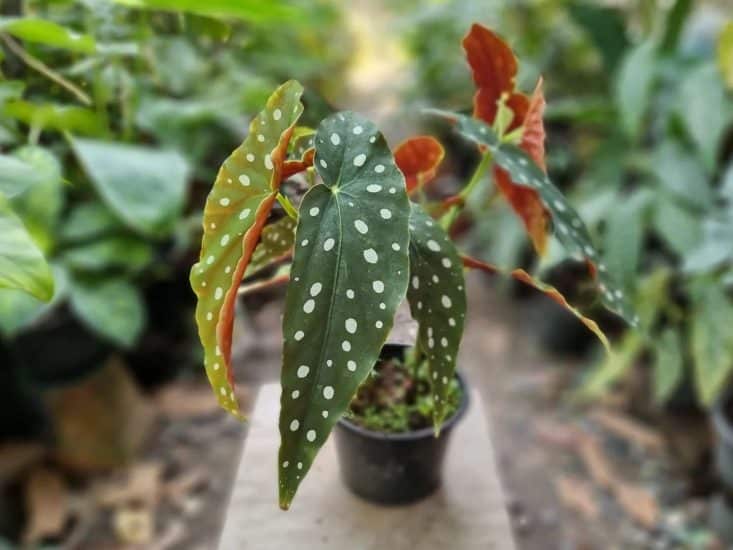
The nodes themselves are beautiful, but don’t be too surprised when you first see leaves emerging. They look pretty sad when they first come out, but they’ll expand and turn green over time.
Begonia Maculata flowers
As you’ll notice throughout this article, Polka dot begonias have beautiful blooms ranging from white to pink. The secret to getting this plant to show off its flowers is well-timed fertilzing during the growing season (we recommend this bloom fertilizer). You’ll want to make sure you have this plant in plenty of humidity, too.
If you do have trouble getting it to flower, just remind yourself: this plant is beloved for its leaves, the flowers are just a nice bonus!
We’ll now briefly cover some of the most popular varieties and then get right into our care guide sections.
(We also have a full Begonia care guide, for all species available.)
Begonia maculata varieties
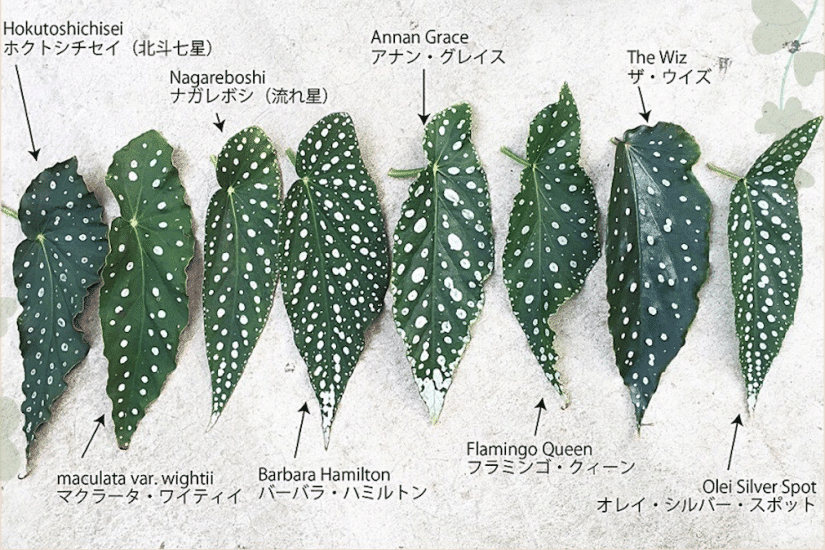
So much care goes into figuring out exactly what kind of plant you have. Is it a Begonia maculata, or is it something else entirely?
There are just so many varieties (hundreds) and species, and many plants have subtle varieties that make it really difficult to distinguish exactly which you might have. We’ll cover some of the more popular and beautiful ones here, but if you purchase a plant called a “Polka dot begonia,” it’s likely labeled primarily on appearance and not some truth encoded deep within the plant.
- Begonia maculata var. wightii. A cultivar with larger silver spots, striking white flowers, a sharp red leaf underside, and olive green leaves that love to soak up indirect light.
- Begonia maculata “Polka Dot”. Deep green leaves bordered with tiny jagged edges. Can be one of a few varieties, but notable for its silvery white polka dots.
- Begonia maculata “My Special Angel”. Can be considered a hybrid of Angel Wing Begonias, they feature thicker stems and prominent angel wing-shaped leaves, and typically grow taller than other varieties. Also called cane begonia.
- Begonia maculata “Raddi”. Features finer silver polka dots than other varieties, and leaves that are a bit deeper green with a more blunted, less angular look.
- Begonia maculata “Flamingo Queen”. Another hybrid with large, dark leaves that can almost border on black. Sports bright pink flowers with silver spots.
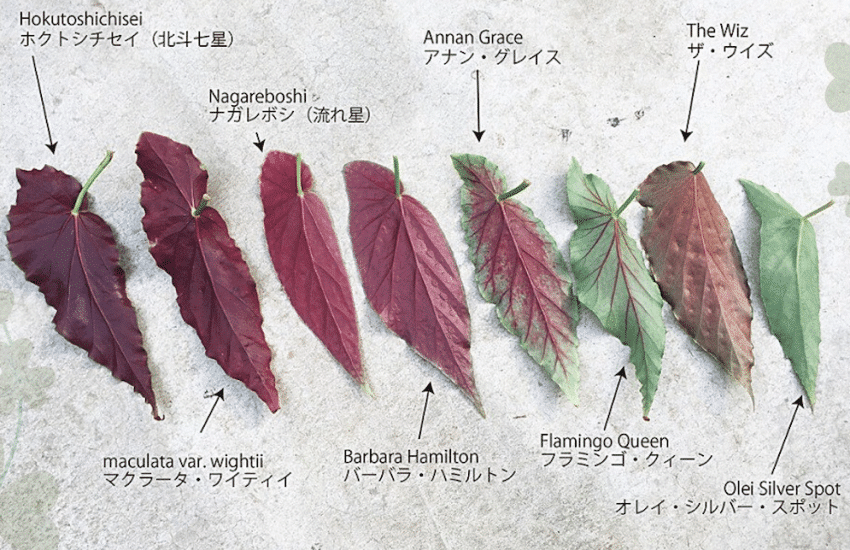
Light
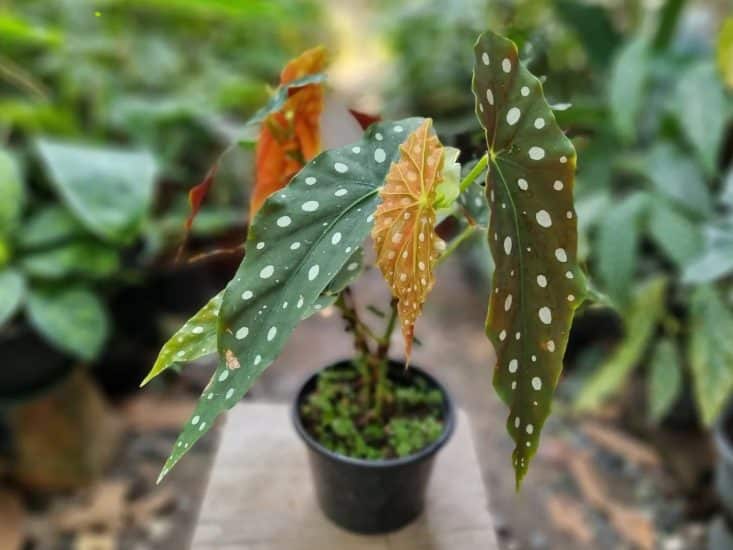
Care for Begonia maculata starts with lighting, and fortunately, this is a pretty flexible plant.
The red undersides to those leaves? They’re the secret ingredient to the Polka dot begonia’s low light tolerance.
This red pigment prevents light from filtering through its leaves, instead letting that energy be reflected back to the chlorophyll in the leaves. So while this plant does do well in bright indirect light, it can tolerate low light a bit better than you might expect.
Pretty cool, right?
While this plant can tolerate short periods of direct light, it’s crucial to ensure it isn’t overexposed. Ideally, you can place these near north or east-facing windows, throw a curtain in front of an exposure facing another direction, or keep them a bit farther away from any direct sunlight.
Signs of not enough light include turning yellow, fading in color, white spots turning green, and finally, leaves (both mature and younger) falling off.
If the plant has been overexposed to light, its leaves may show signs of scorching. Keep an eye out for brown spots on leaves if you suspect it’s getting too much light. During winter when the sun is at its weakest, you can move your Begonia maculata to take advantage of any bright light.
Water
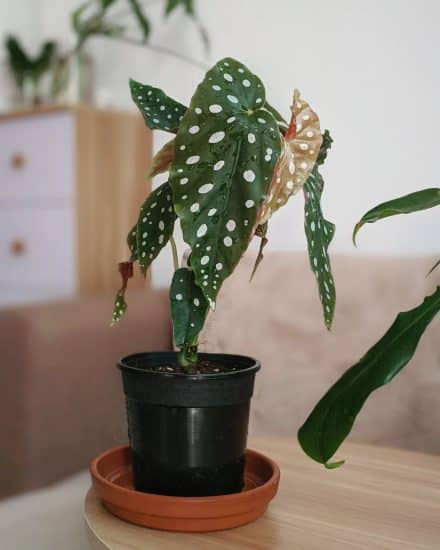
While these are versatile and flexible indoor plants, Begonia maculata care can be a bit tricky when it comes to watering.
The first key is looking at how they appear in their natural habitat: they don’t really look perfect! You’ll notice yellowing and brown edges, and some leaves will lose their color completely.
So don’t be too surprised if your Begonias come out looking a bit different than the pictures you see here or on Instagram.
Begonia maculata do like moist soil, but they also like it to dry out completely between watering. If you use a terracotta pot, this will help the soil dry out more quickly.
How do you know when it’s time to water again? Stick a finger in the soil down two inches. If it feels dry the whole way, it’s time to water. Generally, you won’t want to let the soil dry out for more than a day or two.
Signs of overwatering usually include crispy brown edges, which is often seen in other plants from underwatering. Tricky, I know, just like getting the perfect Begonia maculata leaf.
If you really want these leaves to look perfect (and it’s not essential for the plant that they do) you’ll actually want a moisture meter to really get the right timing. When it reads dry, give your plant a drink.
Just remember that in nature, these plants often look a bit flawed, so don’t obsess too much. They love water, and later we’ll discuss how to mix the perfect soil so that you can water as frequently as they prefer.
Water tips:
- Aim for slightly moist soil rather than soggy – think damp without pooled water. The top layer of the soil should be allowed to dry out between waterings to avoid root rot.
- Use your finger to check the soil near the surface. Is it dry? If so, your plant is ready for a bit of a drink.
- Use tepid water, ideally filtered or even captured rainwater (if you’re that dedicated!)
- Monitor your plant’s leaves for any yellowing, curling, or drooping – if these signs are present, your plant may need more water.
Temperature and humidity
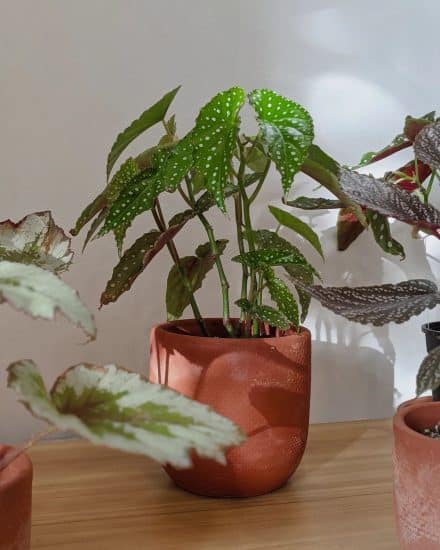
Begonias love humidity, and the maculata is no exception.
When it comes to temperature, the rule of thumb is, “the more tropical, the better”. Aim for a cozy temperature between 65-75 degrees Fahrenheit. Avoid windowsills and vents to help keep it consistent.
Humidity is where the real magic happens. Keep the humidity levels between 45-60%, or a bit higher if you can. You can do this by adding a humidifier – cool mist ones are great, kind of like mini waterfalls right next to your plant.
You can also set up a tray of water with pebbles. I call it the “hot tub” for plants.
And to get the granddaddy of them all, the greenhouse effect, set up a transparent bag over your Begonia maculata to keep the moisture in. Really only needed in the first few weeks of soil propagation.
Now that you know how to create the perfect climate for your Begonia maculata, it’s time to put it into practice.
Tips:
- Aim to keep the temperature of your Begonia maculata between 65-80 degrees Fahrenheit.
- Avoid placing the plant near drafty areas with cool temperatures.
- Avoid misting the leaves with water to prevent attracting pests and diseases.
Soil and planting
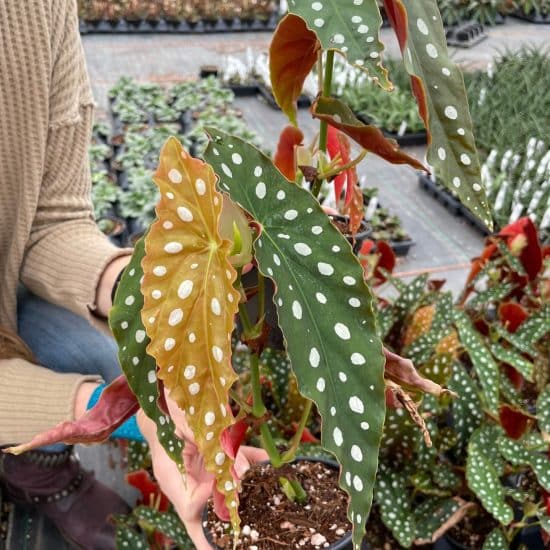
When caring for Begonia maculata, selecting the right soil is important because this plant is especially prone to rot. We’re going to want a lightweight and fast-draining soil mix.
If you don’t want to do too much work, it’s absolutely fine to take store-purchased potting soil and mix in around 20-30% perlite, depending on how often you want to water your plant.
You can also add:
- Worm castings. Adds beneficial microorganisms, a bit of fluffiness, and slow-release nutrients to the soil. You can top dress or mix throughout.
- Horticultural charcoal. Just like the charcoal you’re used to using for a grill but fired at a higher temperature. Very porous with a lot of surface area, which makes it great at improving drainage while absorbing excess moisture. Charcoal can also help filter out impurities in the soil.
- LECA. Most people choose either this, charcoal, or perlite, and not typically all three, because they perform the same function. The main advantage of LECA is that it comes in common sizes, and some find it more visually appealing. The larger size is also beneficial for the roots of some plants, but Begonia will do fine with any of these.
Soggy soil will rot a plant, so really be careful to get this mixture right. Once you have the correct substrate, it’s actually pretty difficult to overwater, just make sure to pick a container with drainage, because Polka dot begonia doesn’t do well in standing water.
If you prefer a decorative pot, simply use the “pot within a pot” technique. Avoid pots that are too big, as this can overburden the begonia’s root system.
For fertilizing, use a balanced houseplant fertilizer every month in the spring and summer, and provide a fertilizer break in fall and winter.
Propagation guide
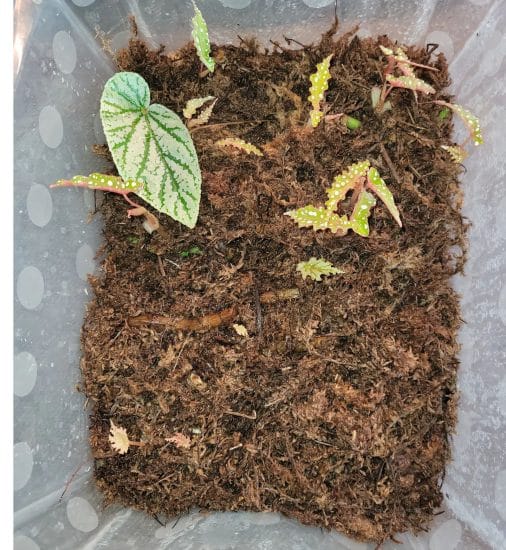
Polka dot begonias are great to propagate. As I mentioned earlier, I actually have trouble growing these tall because I love taking cuttings so much.
Polka dot begonia propagation is really easy because they root from anywhere along their stems, not just from exposed nodes (which you’ll see when removing a leaf/stem).
Propagating Begonia maculata with stem cuttings in water:
First, keep in mind that wherever you cut is going to activate the nodes on that same stem, so take a cutting from a location where you want to see growth occur all the way back down that stem to the plant.
For materials, you’ll want: sterilized gardening shears, a small container with water, and a healthy Polka dot begonia mother plant.
- Cut a 4-6″ segment ideally just below a leaf node and with at least 2 healthy leaves on top.
- Remove any leaves from the bottom nodes to make them available for rooting and so that your leaves don’t decay in water.
- Fill a small container with filtered water and place the cutting inside. You can optionally cover this with a small plastic container (2-liter soda bottles cut in half work great) to keep humidity high. The container should be somewhat small so that the rooting hormones released into it aren’t overly diluted. You can even pair up two cuttings in the same container.
- Change the water every 2-3 days and keep it in bright indirect light.
- When you notice a healthy white root structure 2 inches long, you can transplant it into potting soil and keep it moist with frequent watering for the next few weeks. Don’t overwater.
Soil propagation works well too with Begonia maculata, but water is a lot more reliable, in my experience.
If you’re really fascinated by the plant hormones implicated in which nodes will grow and why, you’ll want to read up on apical buds and auxin (a plant hormone). Once you get a good understanding of how apical buds work, so much of your plant’s habits will make sense.
Propagation tends to work a bit better during the growing season, but if you want to try during the winter, just keep the light and humidity high.
Common issues
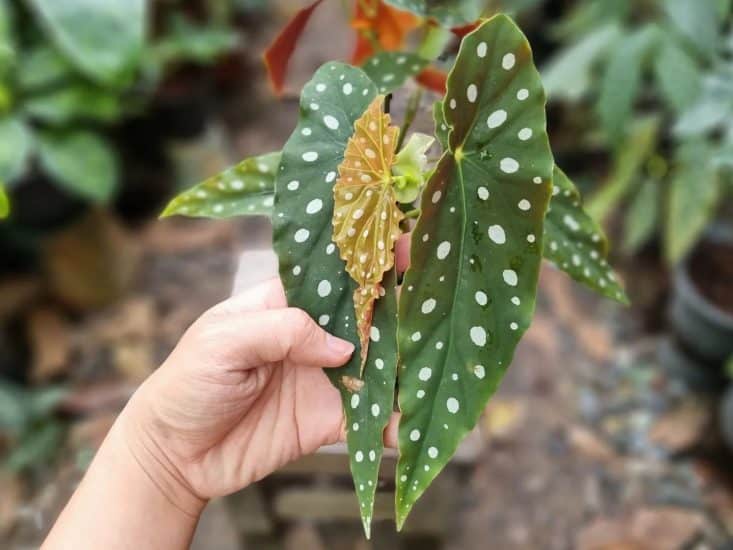
Polka dot begonias do have a few unique issues, but most of what we’ll cover can be found with any indoor plant.
Brown leaf tips
If you do see crispy, brown tips or edges, you’ll want to cut them off, but Polka dot begonia can be prone to infection, so instead of cutting past the damaged section, you’ll want to trim.
Leave a narrow strip of that damaged edge so that you aren’t cutting into the live plant, and this should keep your plant well-protected and safe. That damaged edge will fall off on its own, or you can brush it off with a finger after it becomes crispy.
Spotted leaves fading
If you notice the silver spots on your Polka dot begonia fading or turning yellow/brown, this is commonly due to an issue with light or water. For water you’ll really want to make sure there aren’t impurities, so switch to filtered if possible. As nutrients are leeched out they can sometimes pass through these parts of your leaf and cause damage.
For water, this is often a sign of too little light as the plant makes more chlorophyll to take advantage of how much light it is getting. Just supplement with artificial lighting or move your plant a bit closer to the window, keeping it out of too much direct sun.
Diseases and pests
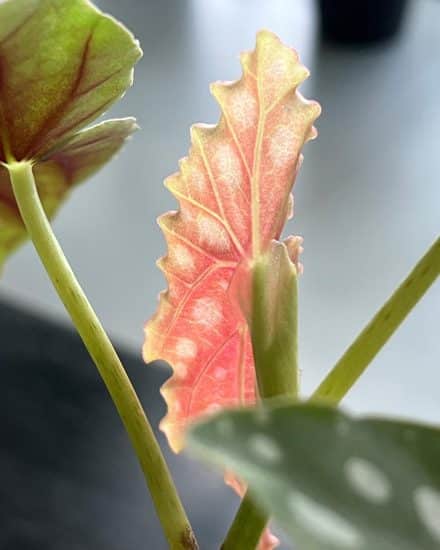
Polka dot begonia really prefers good airflow: avoid misting so that you don’t attract too many pests.
Most of the issues we see are fungus-based, and some people do like to apply a bacterial-based fungicide every 3-4 months along with a neem oil/soapy solution mix.
If you notice spots in the middle of just a few leaves, it’s likely pests. You’ll want to check underneath the leaves, but both mealybugs and spider mites have similar treatments:
- Isolate the plant so that the issue doesn’t spread.
- Take your plant outside and wash it down with a strong spray of water to knock off most of the bugs.
- Wipe down leaves with alcohol or soapy water to remove any remaining pests, making sure to check underneath your leaves.
- Treat with neem oil and then again after another 2-3 weeks to disrupt the lifecycle of any pests.
Root rot
If you spot yellowing leaves, notice small rings or spots in the middle of your leaves, and have roots that look mushy and brown, it’s likely you have an issue with root rot.
This isn’t an uncommon issue for indoor plants, especially begonias. The future fix is good airflow, well-draining soil, and letting the soil dry out between watering.
But first, the immediate problem needs to be addressed. Cut off any affected roots with sterilized shears, repot in fresh soil (adding perlite to increase drainage) in a pot with plenty of drainage. Also, make sure that pot isn’t comically large: more soil usually means that it stays moister for longer, especially if there isn’t an equally large plant ready to drink that moisture right out of the soil.
You can usually save your plant, and you can leave the old pot out in the sun for a week or two and let UV kill off any remaining rot.
Conclusion
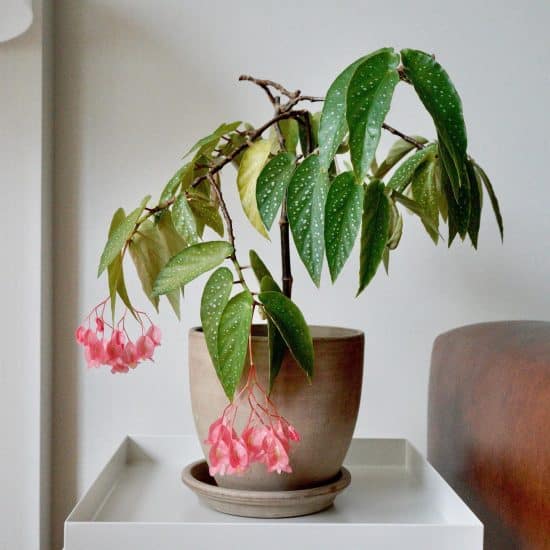
There you have it – you should feel totally confident in taking care of your Polka dot begonia and dealing with any issues that might come up.
Brief care recap:
- Use a light houseplant potting mix enriched with perlite and horticultural charcoal.
- Spotted begonia plants don’t like sitting in soggy soil.
- Lots of bright indirect light.
- Avoid too much direct sunlight from south or west-facing windows.
That’s it for our Begonia maculata care guide. We hope you’ve come to appreciate the polka dot plant just as much as we do.
If you have any questions about which variety you have, or if you just want to share a picture, reach out!
FAQ
Is Begonia maculata hard to care for?
We rate Begonia maculata to be a moderate-difficulty plant. That means while it’s pretty easy to keep alive, there are a few areas where unless you’re meticulous, lucky, or pretty experienced with caring for indoor plants, you might have some trouble . . .
Mainly with watering, because this plant very easily turns brown near its edges if overwatered, yet likes moist soil. Simultaneously, it’s pretty vulnerable to fungus, so things can get tricky.
How big do Begonia maculata get?
Depends! If you have a trellis, you can grow them almost as tall as you. On their own, they’ll be a fair bit shorter, maybe two feet.
Is Polka dot begonia an indoor plant?
Polka dot begonia is very commonly kept indoors, but can be set outside in the spring and summer depending on your local humidity and temperature. If it starts getting 60 F or lower, probably time to take it inside.
Should you mist Begonia maculata?
You can consider misting your Begonia maculata just to clean off its leaves. Don’t leave them wet for too long, since you’re really just removing dust to help out the stomata. If you’re looking to raise humidity, most studies show that misting doesn’t really do much more than attract pests.
Is Begonia maculata toxic to pets?
All Begonia are toxic to dogs and cats. Take care to keep them away from pets and children, as they contain calcium oxalate crystals.
What other issues can Begonia plants experience?
We covered the most common problems above, but powdery mildew can be an issue for some plants kept in too much moisture. You’ll want to mix baking soda with water and spray down your plant anywhere you see the white growth.

